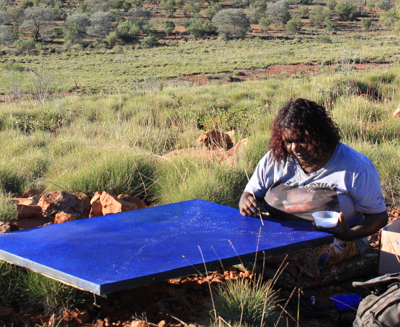| Artist | Gordon Butcher and Alison Pantjiti Multa Napurrula |
|---|---|
| Title | Pikilyi (Vaughn Springs) |
| Year | 2022 |
| Medium | Acrylic on Belgian linen |
| Dimensions | 183 × 152 cm |
| Art Centre | Ikuntji Artists → |
$7,400.00
or $740 x 10 months with

Pay over time with Art Money.
10 payments, 10 months, no interest.
New to Art Money?
Get Started here. Fast, real-time approvals. Approved buyers select Art Money at checkout, enjoy immediately.
Gordon Butcher and Alison Pantjiti Multa Napurrula

Gordon Butcher was born in Papunya in 1963 and was a founding member and drummer of the Warumpi Band. Gordon lived in Ikuntji (Haasts Bluff) with his family. Gordon’s wife, Alison Pantjiti Napurrula Multa is also an artist. He was a respected Elder of the community and Land Council representative. Gordon worked in the studio and also maintained the art centre grounds. He often painted alongside his wife in their spare time. Gordon passed away in early 2020.
Alison Pantjiti Multa Napurrula was born in Mparntwe (Alice Springs) and moved with her mother back to her Country near Ikuntji (Haasts Bluff). She is vice-president of the Ikuntji Community Council, teaches at the Haasts Bluff community school, sits on the regional health board, and paints during most evenings with her daughter Serianne Butcher. Alison was married to Gordon Butcher. Alison’s Country is 200km west of Ikuntji, and home to a permanent dwelling at Brown’s Bore.
Artist statement
Today I paint in the art centre, but not just Tjukurrpa. You can’t just paint anything. Because if you paint anyone’s dreaming, or anyone’s story, you’ll get in trouble, that’s too dangerous. You got to do your own painting, your own story. You got to be careful. You got to do grandmother’s, grandfather’s, not just anyone’s. That’s why I like to do not just Tjukurrpa paintings. Alison Pantjiti Napurrula Multa
This painting shows Pikilyi (Vaughn Springs) west of Yuendumu. This is Gordon Butcher’s father’s and grandfather’s country. Gordon painted both skin groups who are the traditional owners for Pikilyi. The designs on the right and left side of the painting show the skin groups of the Tjapanangkas (blue diamond shapes) and the Tjapangardis (red diamond shapes). The two blue diamond shapes in the middle represent Pikilyi.

